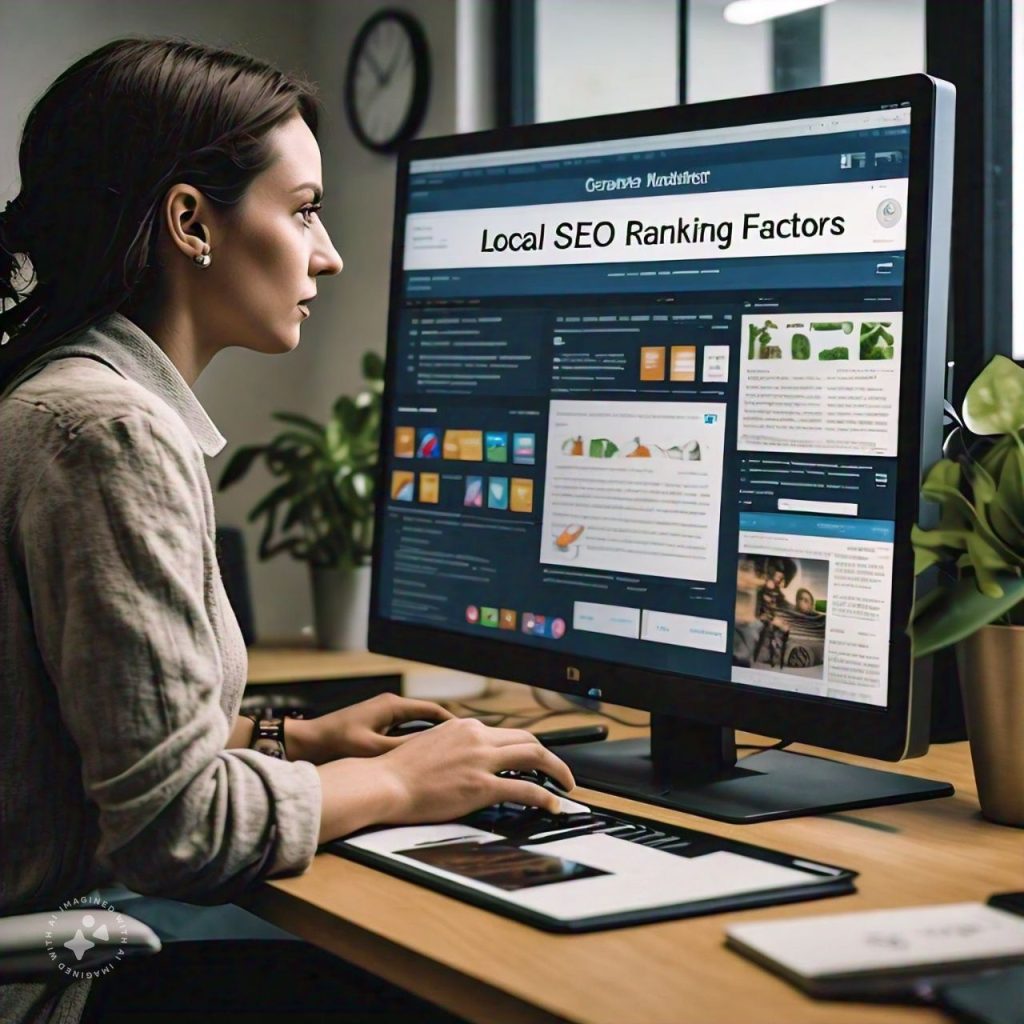Mastering Local SEO for Ranking Success
Visibility is key, and for businesses targeting a regional audience, mastering local SEO for ranking success is crucial.

But what is local SEO? It’s a subset of traditional SEO, focusing on improving online visibility for local searches. This means when potential customers search for services or products you offer in your area, your business shows up. But mastering local SEO isn’t a walk in the park. It requires a deep understanding of various factors. These include local SEO reporting, ranking factors, and optimisation services.

This guide aims to provide that understanding. We’ll delve into the concept of heatmap local SEO 5×5. This innovative approach enhances visibility in local searches. We’ll also explore actionable strategies to improve your local SEO ranking.
Whether you’re a small business owner, a local marketer, or an SEO specialist, this guide is for you. It’s also for digital marketing professionals looking to boost their local search rankings. By the end of this guide, you’ll be well on your way to mastering local SEO for ranking success. Let’s dive in.
Understanding Local SEO
Local SEO is a strategic process. It’s designed to optimize a business’s online presence for local searches. This means when users search for a product or service near them, your business appears. But it’s not just about appearing in any search. It’s about appearing in relevant searches. This relevance is determined by the search engine.
Google, for example, uses various factors to determine relevance. These include the searcher’s location and the content on your website. But it’s not just about Google. Other search engines like Bing and Yahoo also matter. Local SEO ensures your business is visible across all these platforms. This increases your chances of attracting local customers. And that’s what makes local SEO so important for businesses.
The Importance of Local SEO for Businesses
Local SEO is a powerful tool for businesses. Especially for those targeting a regional audience.

It helps businesses stand out in local searches. This increases visibility among potential customers in your area. And with increased visibility comes increased traffic. Both to your website and your physical location. This can lead to higher sales and revenue. But it’s not just about sales. Local SEO also helps build brand awareness.
When your business consistently appears in local searches, people start recognizing your brand. This can lead to increased trust and loyalty among customers. And in the long run, it can contribute to the growth and success of your business.

Local SEO vs. Traditional SEO: What’s the Difference?
Local SEO and traditional SEO are similar. Both aim to improve a website’s visibility in search engines. But the key difference lies in the scope. Traditional SEO focuses on improving your website’s visibility on a national or global scale. It involves optimizing your website to rank for specific keywords. Local SEO, on the other hand, focuses on local searches.
It involves optimizing your online presence to attract local customers. This includes optimizing your Google My Business listing and managing online reviews. It also involves ensuring your business’s name, address, and phone number (NAP) are consistent across the web. In short, while traditional SEO helps you reach a global audience, local SEO helps you attract customers in your area.

Local SEO Ranking Factors
Local SEO ranking factors are the elements that search engines consider when ranking a website for local searches. These factors can be divided into several categories.

These include on-page signals, off-page signals, and behavioral signals. On-page signals refer to the elements on your website that you can control. These include your content, meta tags, and website structure. Off-page signals refer to the elements outside your website that affect your rankings.
These include backlinks, social signals, and online reviews. Behavioral signals refer to how users interact with your website. These include click-through rates, bounce rates, and time spent on site. Understanding these ranking factors is crucial for local SEO success. It allows you to optimize your online presence to rank higher in local searches.

Proximity, Relevance, and Prominence: The Pillars of Local SEO
Proximity, relevance, and prominence are the three pillars of local SEO.

It refers to how close a business is to the searcher’s location. The closer the business, the higher it ranks in local searches. Relevance refers to how well a business matches the searcher’s query. The more relevant the business, the higher it ranks. Prominence refers to how well-known a business is. The more prominent the business, the higher it ranks. These three factors play a crucial role in local SEO. They determine how well a business ranks in local searches.
On-Page Signals and Their Impact on Local SEO
On-page signals are the elements on your website that you can control. These include your content, meta tags, and website structure. Optimizing these elements can significantly improve your local SEO. For example, by optimizing your content for local keywords, you can rank higher in local searches.
Similarly, by optimizing your meta tags, you can make your website more relevant to local queries. And by improving your website structure, you can make it easier for search engines to understand your site. All these factors contribute to your local SEO success.
The Role of Google My Business in Local SEO
Google My Business (GMB) is a free tool from Google. It allows businesses to manage their online presence across Google, including Search and Maps. By claiming and optimizing your GMB listing, you can improve your local SEO.
Your GMB listing provides users with important information about your business. This includes your business name, address, phone number, and operating hours. It also includes customer reviews, photos, and a link to your website. All this information helps users make informed decisions about your business. And the more complete and accurate your GMB listing, the higher you rank in local searches.
Importance of Reviews and Ratings
Reviews and ratings play a crucial role in local SEO. They provide social proof and build trust with potential customers. They also influence your local search rankings. The more positive reviews you have, the higher you rank in local searches. But it’s not just about the quantity of reviews. The quality of reviews also matters. High-quality, positive reviews can significantly improve your local SEO.
Local Backlinks: Building Authority in Your Area
Backlinks are links from other websites to your website. In the context of local SEO, local backlinks are particularly important. These are links from other local websites to your website. They help build authority and credibility in your area. And the more local backlinks you have, the higher you rank in local searches.
But it’s not just about the quantity of backlinks. The quality of backlinks also matters. High-quality, relevant backlinks can significantly improve your local SEO.

Optimizing for Local SEO
Optimizing for local SEO involves several steps. These steps aim to improve your online presence for local searches. They include claiming and optimizing your Google My Business listing, ensuring NAP consistency across the web, creating local content, and optimizing for mobile users.
By following these steps, you can significantly improve your local SEO. This can lead to higher rankings in local searches, more website traffic, and ultimately, more customers.

Claiming and Optimizing Your Google My Business Listing
Claiming and optimizing your Google My Business (GMB) listing is a crucial step in local SEO. Your GMB listing provides users with important information about your business. This includes your business name, address, phone number, and operating hours. It also includes customer reviews, photos, and a link to your website.
To claim your GMB listing, you need to follow several steps.
- Go to the Google My Business website.
- Click on “Manage now”.
- Enter your business name.
- Follow the prompts to claim your business.
Once you’ve claimed your GMB listing, you need to optimize it. This involves providing complete and accurate information about your business. It also involves regularly updating your listing with new photos, posts, and offers. By doing so, you can make your GMB listing more appealing to users and more relevant to local searches.
NAP Consistency Across the Web
NAP stands for Name, Address, and Phone number. This consistency refers to the consistency of your business information across the web. This includes your website, social media profiles, and online directories. Ensuring NAP consistency is crucial for local SEO. It helps search engines understand your business and its location.
And the more consistent your NAP, the higher you rank in local searches. To ensure NAP consistency, you need to regularly audit your online presence. This involves checking your business information on all platforms and correcting any inconsistencies. By doing so, you can improve your local SEO and increase your visibility in local searches.

Creating Local Content for Engagement and Relevance
Creating local content is another important step in local SEO. Local content refers to content that is relevant to your local audience. This includes blog posts, videos, infographics, and social media posts. By creating local content, you can engage your local audience and improve your local SEO.
Local content can also help you rank for local keywords. These are keywords that include a specific location, such as “pizza in New York”. By targeting these keywords, you can attract more local traffic to your website. And the more local traffic you have, the higher you rank in local searches.
Mobile Optimization: Catering to the Local Mobile User
Mobile optimization is a crucial factor in local SEO. This is because a large portion of local searches are conducted on mobile devices. In fact, according to Google, more than half of all web traffic comes from mobile. This means that if your website is not optimized for mobile, you could be missing out on a significant amount of local traffic.
Mobile optimization involves several steps. These include making your website responsive, improving your site speed, and optimizing your site for touch. By following these steps, you can provide a better user experience for mobile users. And the better your user experience, the higher you rank in local searches.
Advanced Local SEO Strategies
Local SEO is not just about the basics. There are also advanced strategies that can give you an edge. These strategies include using heatmap local SEO 5×5, implementing schema markup, and leveraging social media. By using these advanced strategies, you can further improve your local SEO. This can lead to even higher rankings in local searches, more website traffic, and more customers.

Heatmap Local SEO 5×5: Understanding User Behavior
Heatmap local SEO 5×5 is a strategy that involves using heatmaps to understand user behavior. A heatmap is a visual representation of data. In the context of SEO, it shows how users interact with your website. This includes where they click, how far they scroll, and what they ignore. By using a heatmap, you can gain insights into how users interact with your website. And you can use these insights to optimize your website for better user experience and higher conversions.
There are several tools available for creating heatmaps. These include Crazy Egg, Hotjar, and Mouseflow. By using these tools, you can create a heatmap of your website and analyze user behavior. And by understanding user behavior, you can make data-driven decisions to improve your local SEO.
Schema Markup for Enhanced Local Visibility
Schema markup is a type of microdata. It’s added to your website to help search engines understand your content. And it can significantly improve your local SEO. This is because schema markup provides search engines with detailed information about your business.
This includes your business name, address, phone number, operating hours, and reviews. By providing this information, you can help search engines understand your business and its location. And the more search engines understand your business, the higher you rank in local searches.

Several types of schema markup are relevant for local SEO. These include LocalBusiness, Organization, and Place. By using these types of schema markup, you can provide search engines with detailed information about your business. And by providing detailed information, you can improve your local SEO and increase your visibility in local searches.
Leveraging Social Media for Local SEO
Social media can also play a role in local SEO. This is because social media profiles often rank in search results. And they can drive traffic to your website. By leveraging social media, you can improve your local SEO. This involves creating and optimizing your social media profiles, posting regular updates, and engaging with your audience. By doing so, you can increase your online presence and improve your local SEO.
There are several social media platforms that are relevant for local SEO. These include Facebook, Instagram, Twitter, and LinkedIn. By using these platforms, you can reach a larger audience and drive more traffic to your website. And the more traffic you have, the higher you rank in local searches. So, don’t overlook social media in your local SEO strategy. It can be a powerful tool for improving your local SEO and increasing your online visibility.

Local SEO Reporting and Analytics
Local SEO is not a set-and-forget strategy. It requires ongoing monitoring and analysis. This is where local SEO reporting and analytics come in. By tracking key metrics and using the right tools, you can measure the success of your local SEO efforts. And you can make data-driven decisions to improve your local SEO.
Local SEO reporting and analytics involve tracking key metrics. These include organic traffic, local search rankings, and conversions. By tracking these metrics, you can measure the success of your local SEO efforts. And you can identify areas for improvement. But tracking these metrics requires the right tools. And there are several tools available for local SEO reporting and analytics.
These include Google Analytics, Google Search Console, and SEMrush. By using these tools, you can track key metrics and measure the success of your local SEO efforts. And you can make data-driven decisions to improve your local SEO.
Key Metrics to Track in Local SEO
There are several key metrics to track in local SEO. These include organic traffic, local search rankings, and conversions. Organic traffic refers to visitors who arrive at your website through unpaid search results. Local search rankings refer to your position in local search results. And conversions refer to visitors who take a desired action on your website.

By tracking these key metrics, you can measure the success of your local SEO efforts. And you can identify areas for improvement. For example, if your organic traffic is low, you may need to improve your content or on-page SEO. If your local search rankings are low, you may need to improve your local SEO.
And if your conversions are low, you may need to improve your website design or call-to-action. By tracking these key metrics, you can make data-driven decisions to improve your local SEO.
Tools for Local SEO Reporting
There are several tools available for local SEO reporting. These include Google Analytics, Google Search Console, and SEMrush. Google Analytics is a free tool that allows you to track website traffic and user behavior. Google Search Console is a free tool that allows you to monitor your website’s presence in Google search results. And SEMrush is a paid tool that provides comprehensive SEO data, including keyword rankings, backlink analysis, and competitor research.
By using these tools, you can track key metrics and measure the success of your local SEO efforts. And you can make data-driven decisions to improve your local SEO. For example, you can use Google Analytics to track organic traffic and user behavior. You can use Google Search Console to monitor your website’s presence in Google search results.
And you can use SEMrush to conduct keyword research, analyze backlinks, and research competitors. By using these tools, you can improve your local SEO reporting and analytics. And you can make data-driven decisions to improve your local SEO.
Local SEO for Multiple Locations
Managing local SEO for multiple locations can be a challenge. Each location has its own unique characteristics and needs. And each location requires a tailored approach to local SEO. But with the right strategies, you can effectively manage local SEO for multiple locations. And you can improve your local search rankings and visibility across all locations.

Managing local SEO for multiple locations involves several key steps. These include creating a unique Google My Business listing for each location. Optimizing your website for each location. And building local citations and backlinks for each location. By following these steps, you can effectively manage local SEO for multiple locations. And you can improve your local search rankings and visibility across all locations.
Managing Local SEO Across Different Regions
Managing local SEO across different regions requires a tailored approach. Each region has its own unique characteristics and needs. And each region requires a unique approach to local SEO.
For example, the keywords that are popular in one region may not be popular in another. The local competitors in one region may not be the same as in another. And the local search behavior in one region may not be the same as in another.
By understanding these regional differences, you can tailor your local SEO strategy for each region. And you can improve your local search rankings and visibility in each region.
Strategies for Scaling Local SEO Efforts
Scaling local SEO efforts for multiple locations can be a challenge. But with the right strategies, you can effectively scale your local SEO efforts. And you can improve your local search rankings and visibility across all locations.

One strategy is to create a unique Google My Business listing for each location. This allows you to manage and optimize each location individually. Another strategy is to optimize your website for each location. This includes creating unique content for each location.
And optimizing your website for location-specific keywords. A third strategy is to build local citations and backlinks for each location. This helps to build authority and relevance for each location. By following these strategies, you can effectively scale your local SEO efforts. And you can improve your local search rankings and visibility across all locations.
Local SEO Optimisation Services
Local SEO can be complex. It involves many different factors and strategies. And it requires a deep understanding of local search algorithms. For many businesses, managing local SEO in-house can be a challenge. This is where local SEO optimisation services come in.
Local SEO optimisation services are professional services that help businesses improve their local search rankings and visibility. These services can provide a range of benefits. They can help businesses save time and resources. They can provide expert knowledge and insights. And they can help businesses achieve better results with their local SEO efforts.
But not all local SEO optimisation services are created equal. It’s important to choose a service provider that can meet your specific needs and goals.
When to Consider Professional Local SEO Services
There are several situations when you might consider professional local SEO services. One is when you’re just starting out with local SEO. In this case, a professional service can provide the expertise and guidance you need to get started.
Another situation is when you’re struggling to improve your local search rankings and visibility. A professional service can help identify the issues and provide solutions. A third situation is when you’re looking to scale your local SEO efforts. A professional service can provide the resources and strategies needed to scale effectively.
Finally, you might consider professional services if you simply don’t have the time or resources to manage local SEO in-house. In this case, a professional service can take over the management of your local SEO, freeing up your time and resources for other tasks.
What to Look for in a Local SEO Service Provider
When choosing a local SEO service provider, there are several factors to consider. First, look for a provider with a proven track record in local SEO. They should be able to provide case studies or testimonials from previous clients. Second, look for a provider that offers a range of local SEO services. These might include Google My Business management, local citation building, and local content creation.
Third, look for a provider that uses ethical, white-hat SEO strategies. Avoid providers that promise quick results through questionable tactics. Finally, look for a provider that offers transparent reporting. You should be able to see exactly what they’re doing and how it’s impacting your local search rankings and visibility. By considering these factors, you can choose a local SEO service provider that can meet your specific needs and goals.
Future Trends in Local SEO
The world of SEO is always evolving. New technologies and trends are constantly emerging. And these can have a big impact on local SEO. To stay ahead of the competition, it’s important to keep an eye on these trends. And to adapt your local SEO strategies accordingly.
In this section, we’ll look at two key trends that are shaping the future of local SEO. These are voice search and artificial intelligence (AI). Both of these trends have the potential to significantly change the way we approach local SEO. And both offer exciting opportunities for businesses looking to improve their local search rankings and visibility. Let’s take a closer look at each of these trends.
Voice Search and Its Impact on Local SEO
Voice search is becoming increasingly popular. More and more people are using voice assistants like Siri and Alexa to search the web. And this has important implications for local SEO.
For one, voice search queries are often more conversational. They tend to be longer and more specific. This means that businesses need to optimize for long-tail, conversational keywords. Voice search also often has a local intent. People use voice search to find local businesses, get directions, and more. So businesses need to ensure that their local SEO is on point.
The Role of AI and Machine Learning in Local SEO
AI and machine learning are also having a big impact on local SEO. Search engines are using these technologies to better understand search queries. And to provide more relevant and personalized search results.
For businesses, this means that traditional keyword optimization is no longer enough. They need to understand the intent behind search queries. And they need to provide content that meets this intent. AI and machine learning can also help businesses analyze their local SEO data. They can identify patterns and trends that humans might miss.
And they can provide insights that can help businesses improve their local SEO strategies. In conclusion, voice search and AI are two key trends shaping the future of local SEO. By understanding and adapting to these trends, businesses can stay ahead of the competition and achieve local SEO success.
Conclusion: The Continuous Evolution of Local SEO
Local SEO is not a static field. It’s constantly evolving and changing. And businesses need to keep up with these changes if they want to stay competitive.

The strategies that worked a few years ago might not work today. And the strategies that work today might not work in the future. That’s why it’s so important to stay informed about the latest trends and developments in local SEO. And to be willing to adapt and change your strategies as needed. But while the specifics of local SEO might change, the underlying principles remain the same.
It’s about making your business visible and attractive to local customers. It’s about providing valuable and relevant content. And it’s about building relationships and trust with your local community. So while the tactics might change, the goal remains the same. And with the right approach and mindset, you can master local SEO and achieve lasting success.
Appendix: Local SEO Checklist
Local SEO can seem overwhelming. There are so many factors to consider and tasks to complete. But don’t worry. We’ve put together a handy checklist to help you stay on track.
Here are the key steps you should take to optimize your local SEO:
- Claim and optimize your Google My Business listing.
- Ensure NAP (Name, Address, Phone Number) consistency across the web.
- Optimize your website for mobile users.
- Create local content that engages and informs your audience.
- Build local backlinks to increase your authority.
- Encourage and respond to customer reviews.
- Use schema markup to enhance your local visibility.
- Leverage social media to boost your local SEO efforts.
- Monitor your local SEO performance and adjust your strategies as needed.
- Stay informed about the latest trends and developments in local SEO.
Remember, local SEO is not a one-time task. It requires ongoing effort and attention. But with this checklist, you’ll have a clear roadmap to follow. And you’ll be well on your way to local SEO success.
References and Further Reading
For more in-depth information on local SEO, consider these resources:
- Google’s guide to improving your local ranking on Google is a must-read. It provides valuable insights straight from the source.
- Moz’s Local Search Ranking Factors survey offers a comprehensive look at the factors that influence local SEO.
- The Local SEO section on Search Engine Journal is regularly updated with articles and tips from industry experts.
- BrightLocal’s blog is another excellent resource, with a focus on practical advice and case studies.
- Finally, the Local Search Forum is a great place to ask questions and learn from other local SEO professionals.


